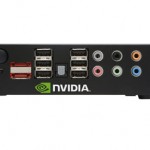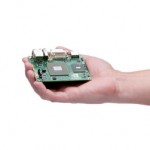You will soon be hearing a lot about Nvidia’s new Ion platform. There will be a whole bunch of hype, superlatives and marketing jargon to go along with it, but if you boil it all down, Nvidia Ion’s main purpose will be to give HD where HD wasn’t possible before.
Intel’s Atom processor has been a huge success in the netbook market. Netbooks are a needed stepping stone between the ever more powerful smartphone, and the laptop. Netbooks are perfect for basic office work, Internet and will give you some multimedia potentials. They usually employ an Intel GMA 950 GPU, which will allow you to do all the basic stuff, but try to do anything more taxing like playing back a 720p H.264 video, and you’ll find it struggling, along with the Atom processor, in trying to deal with it. So while netbooks and other similar mini computers are great for most tasks, today’s multimedia demands mean that they won’t have a place in your home theater as a media player.
Nvidia’s Ion platform seeks to change this notion.
By including a Nvidia GeForce 9400M into the package, as opposed to using the Intel GMA GPU. Apart from being an tiny GPU that fits well into devices normally powered bt the Atom, the 9400M also features Nvidia’s 3rd generation PureVideo HD (or VP3) acceleration engine designed specifically for enhanced HD playback, including full hardware decoding for all the Blu-ray video codecs. The 3rd gen VP3 is only seen on some of the more recent GeForce GPUs, and not even the GTX 2xx range have them (they are still using the 2nd gen., which cannot do full VC-1 hardware decoding, only full H.264 decoding). What this means is that the GPU will handle most of the load for playing back HD movies and this now allows Atom based systems to play back 1080p HD movies.
This then allows Atom based systems to have a genuine place inside your home theater. The small form factor and lack of heat (and therefore, noise) will be perfect in the home theater, and with 1080p HD H.264 or VC-1 playback, it will handle all of your multimedia needs without having a dedicated PC hooked up to your system. Increase the form factor a bit and add in a Blu-ray drive, and you’ve got yourself a full HTPC system for maybe only half the cost, half the space, and half the noise. And unplug all the cables, and it’s portable too. The 9400M will support Nvidia’s CUDA platform, which means GPU will be able to assist the CPU in many other tasks.
What Ion, and the 9400M, won’t offer you is gaming potential, because in order to reduce the heat output and power requirements to fit into Atom systems, a few corners had to be cut – the 9400M only features 16 stream processors, compared to the 480 you get with Nvidia’s top of the range GPU. 2D graphics won’t be much better than Intel GMA based systems either. But video, and HD video at that, has always been the main draw here.
Intel will fight the Ion platform by introducing new CPUs that can handle 720p video using less power and at less cost than Ion, but 1080p video is where things are heading at the moment and there appears to be a bright future for Ion as long as system builders, like Asus, take full advantage.



